Market Entry Analysis: Telstra's Expansion into Estonia and Jordan
VerifiedAdded on 2023/06/07
|10
|2447
|380
Report
AI Summary
This report provides a comprehensive analysis of Telstra Corporation's potential market entry into Estonia and Jordan. It examines the macro-environmental and geopolitical forces impacting each country, including demographic, ecological, socio-cultural, and technological forces, as well as political instability and geopolitical risks. The report assesses the current trade and business policies of Estonia and Jordan, highlighting potential dangers, risks, and opportunities for Telstra. The analysis considers factors such as free trade, job losses, tax troubles, and dependence on foreign capital. Based on this evaluation, the report recommends Jordan as the more suitable market for Telstra's expansion, emphasizing its higher population, growth potential, and fewer risks compared to Estonia. The analysis is supported by references to relevant academic sources, and is a past assignment contributed by a student to Desklib for educational purposes.
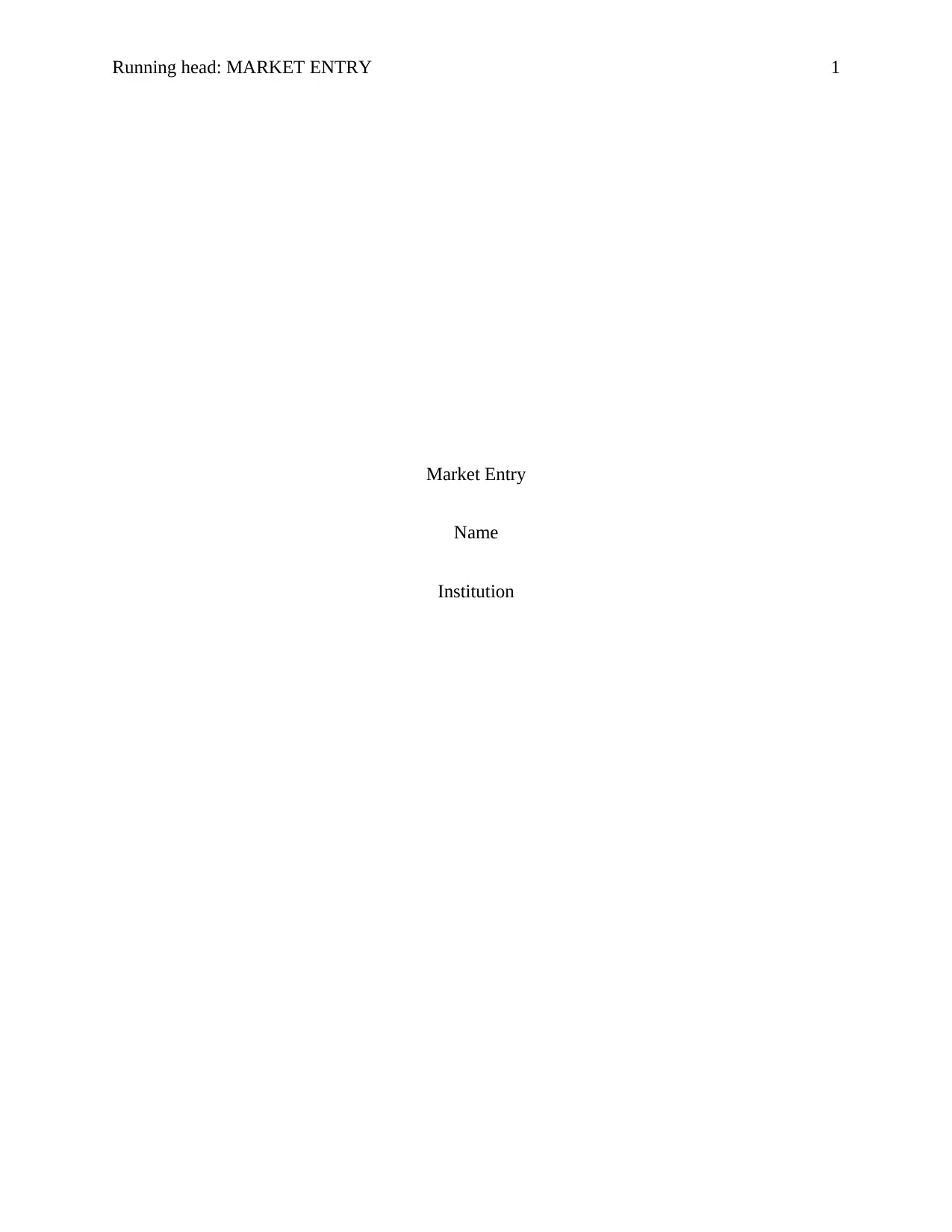
Running head: MARKET ENTRY 1
Market Entry
Name
Institution
Market Entry
Name
Institution
Paraphrase This Document
Need a fresh take? Get an instant paraphrase of this document with our AI Paraphraser
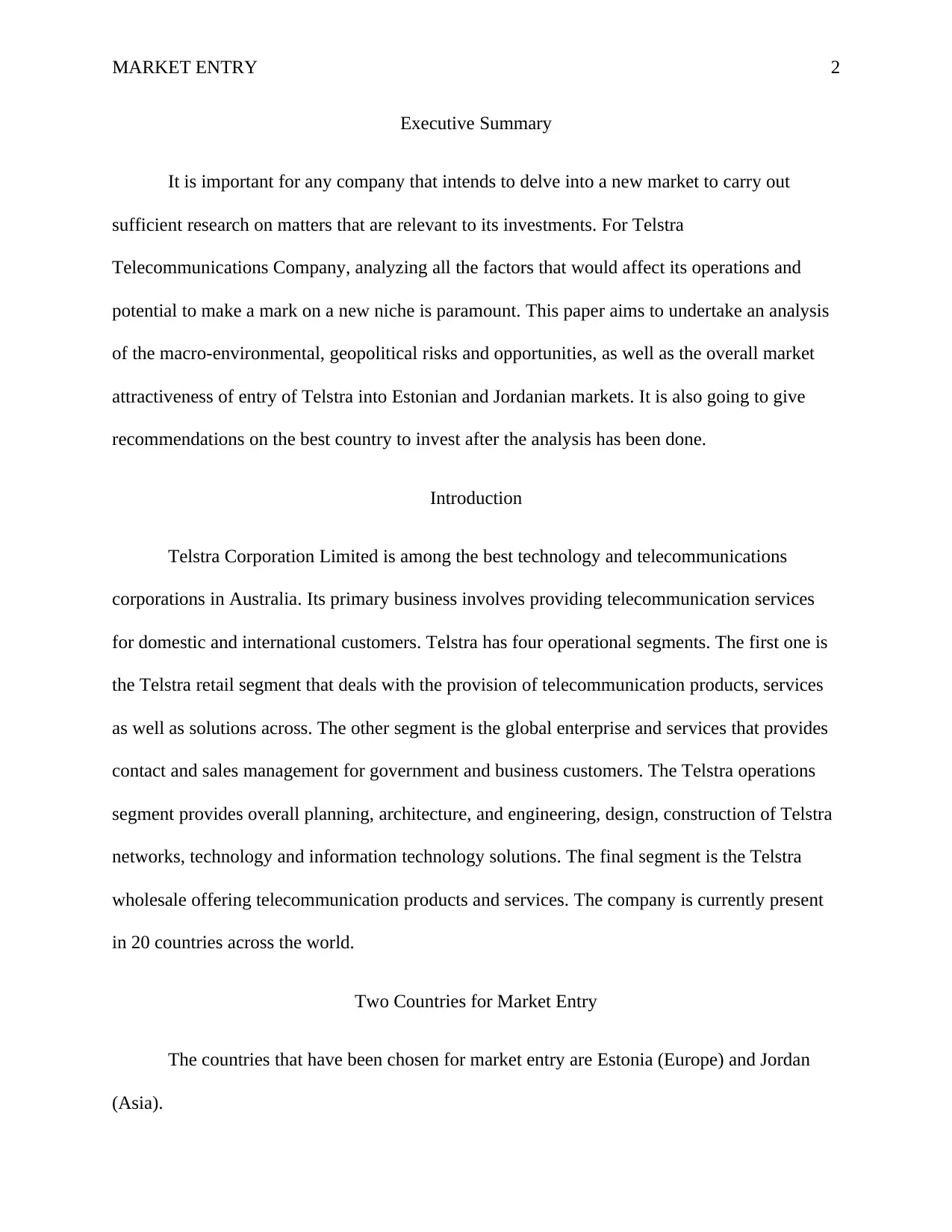
MARKET ENTRY 2
Executive Summary
It is important for any company that intends to delve into a new market to carry out
sufficient research on matters that are relevant to its investments. For Telstra
Telecommunications Company, analyzing all the factors that would affect its operations and
potential to make a mark on a new niche is paramount. This paper aims to undertake an analysis
of the macro-environmental, geopolitical risks and opportunities, as well as the overall market
attractiveness of entry of Telstra into Estonian and Jordanian markets. It is also going to give
recommendations on the best country to invest after the analysis has been done.
Introduction
Telstra Corporation Limited is among the best technology and telecommunications
corporations in Australia. Its primary business involves providing telecommunication services
for domestic and international customers. Telstra has four operational segments. The first one is
the Telstra retail segment that deals with the provision of telecommunication products, services
as well as solutions across. The other segment is the global enterprise and services that provides
contact and sales management for government and business customers. The Telstra operations
segment provides overall planning, architecture, and engineering, design, construction of Telstra
networks, technology and information technology solutions. The final segment is the Telstra
wholesale offering telecommunication products and services. The company is currently present
in 20 countries across the world.
Two Countries for Market Entry
The countries that have been chosen for market entry are Estonia (Europe) and Jordan
(Asia).
Executive Summary
It is important for any company that intends to delve into a new market to carry out
sufficient research on matters that are relevant to its investments. For Telstra
Telecommunications Company, analyzing all the factors that would affect its operations and
potential to make a mark on a new niche is paramount. This paper aims to undertake an analysis
of the macro-environmental, geopolitical risks and opportunities, as well as the overall market
attractiveness of entry of Telstra into Estonian and Jordanian markets. It is also going to give
recommendations on the best country to invest after the analysis has been done.
Introduction
Telstra Corporation Limited is among the best technology and telecommunications
corporations in Australia. Its primary business involves providing telecommunication services
for domestic and international customers. Telstra has four operational segments. The first one is
the Telstra retail segment that deals with the provision of telecommunication products, services
as well as solutions across. The other segment is the global enterprise and services that provides
contact and sales management for government and business customers. The Telstra operations
segment provides overall planning, architecture, and engineering, design, construction of Telstra
networks, technology and information technology solutions. The final segment is the Telstra
wholesale offering telecommunication products and services. The company is currently present
in 20 countries across the world.
Two Countries for Market Entry
The countries that have been chosen for market entry are Estonia (Europe) and Jordan
(Asia).
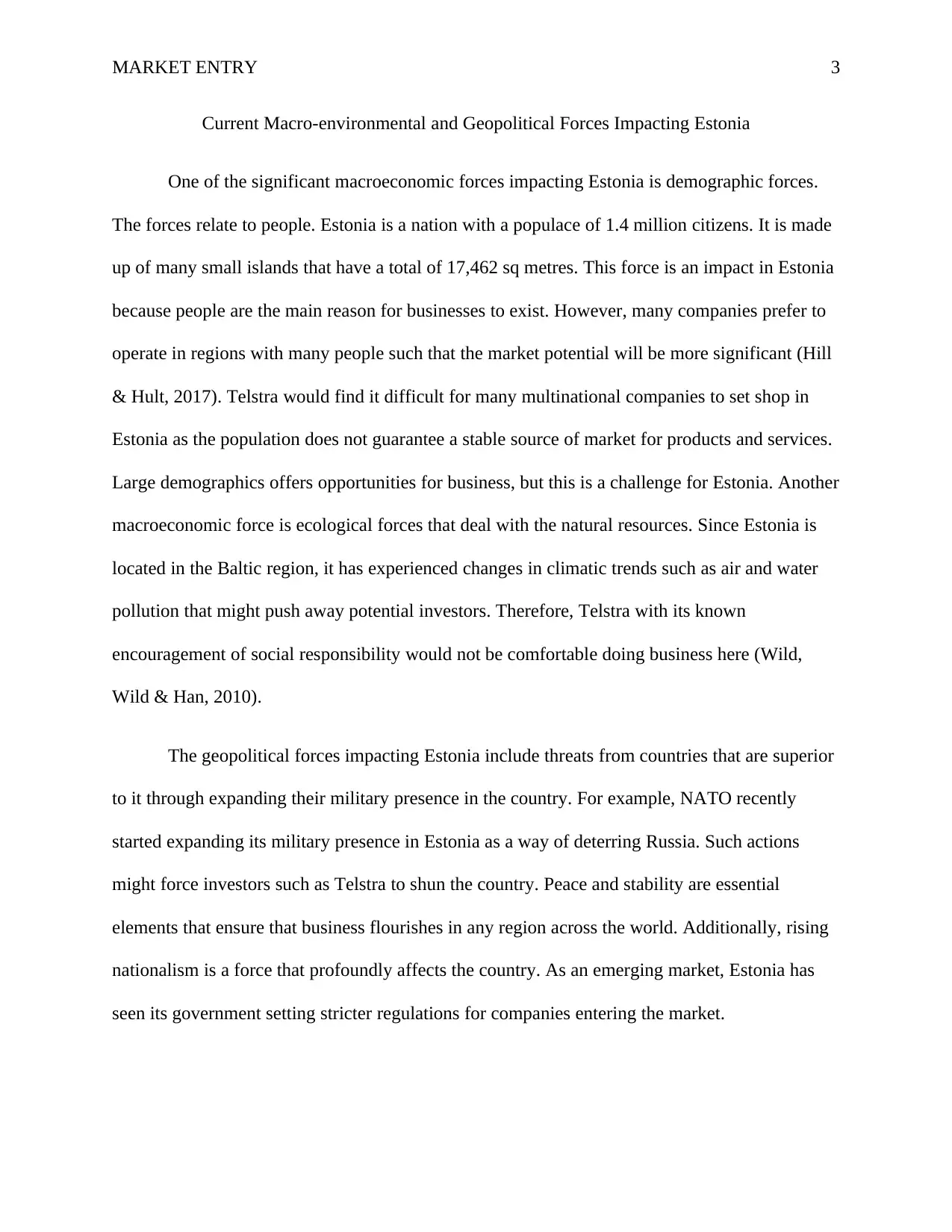
MARKET ENTRY 3
Current Macro-environmental and Geopolitical Forces Impacting Estonia
One of the significant macroeconomic forces impacting Estonia is demographic forces.
The forces relate to people. Estonia is a nation with a populace of 1.4 million citizens. It is made
up of many small islands that have a total of 17,462 sq metres. This force is an impact in Estonia
because people are the main reason for businesses to exist. However, many companies prefer to
operate in regions with many people such that the market potential will be more significant (Hill
& Hult, 2017). Telstra would find it difficult for many multinational companies to set shop in
Estonia as the population does not guarantee a stable source of market for products and services.
Large demographics offers opportunities for business, but this is a challenge for Estonia. Another
macroeconomic force is ecological forces that deal with the natural resources. Since Estonia is
located in the Baltic region, it has experienced changes in climatic trends such as air and water
pollution that might push away potential investors. Therefore, Telstra with its known
encouragement of social responsibility would not be comfortable doing business here (Wild,
Wild & Han, 2010).
The geopolitical forces impacting Estonia include threats from countries that are superior
to it through expanding their military presence in the country. For example, NATO recently
started expanding its military presence in Estonia as a way of deterring Russia. Such actions
might force investors such as Telstra to shun the country. Peace and stability are essential
elements that ensure that business flourishes in any region across the world. Additionally, rising
nationalism is a force that profoundly affects the country. As an emerging market, Estonia has
seen its government setting stricter regulations for companies entering the market.
Current Macro-environmental and Geopolitical Forces Impacting Estonia
One of the significant macroeconomic forces impacting Estonia is demographic forces.
The forces relate to people. Estonia is a nation with a populace of 1.4 million citizens. It is made
up of many small islands that have a total of 17,462 sq metres. This force is an impact in Estonia
because people are the main reason for businesses to exist. However, many companies prefer to
operate in regions with many people such that the market potential will be more significant (Hill
& Hult, 2017). Telstra would find it difficult for many multinational companies to set shop in
Estonia as the population does not guarantee a stable source of market for products and services.
Large demographics offers opportunities for business, but this is a challenge for Estonia. Another
macroeconomic force is ecological forces that deal with the natural resources. Since Estonia is
located in the Baltic region, it has experienced changes in climatic trends such as air and water
pollution that might push away potential investors. Therefore, Telstra with its known
encouragement of social responsibility would not be comfortable doing business here (Wild,
Wild & Han, 2010).
The geopolitical forces impacting Estonia include threats from countries that are superior
to it through expanding their military presence in the country. For example, NATO recently
started expanding its military presence in Estonia as a way of deterring Russia. Such actions
might force investors such as Telstra to shun the country. Peace and stability are essential
elements that ensure that business flourishes in any region across the world. Additionally, rising
nationalism is a force that profoundly affects the country. As an emerging market, Estonia has
seen its government setting stricter regulations for companies entering the market.
⊘ This is a preview!⊘
Do you want full access?
Subscribe today to unlock all pages.

Trusted by 1+ million students worldwide
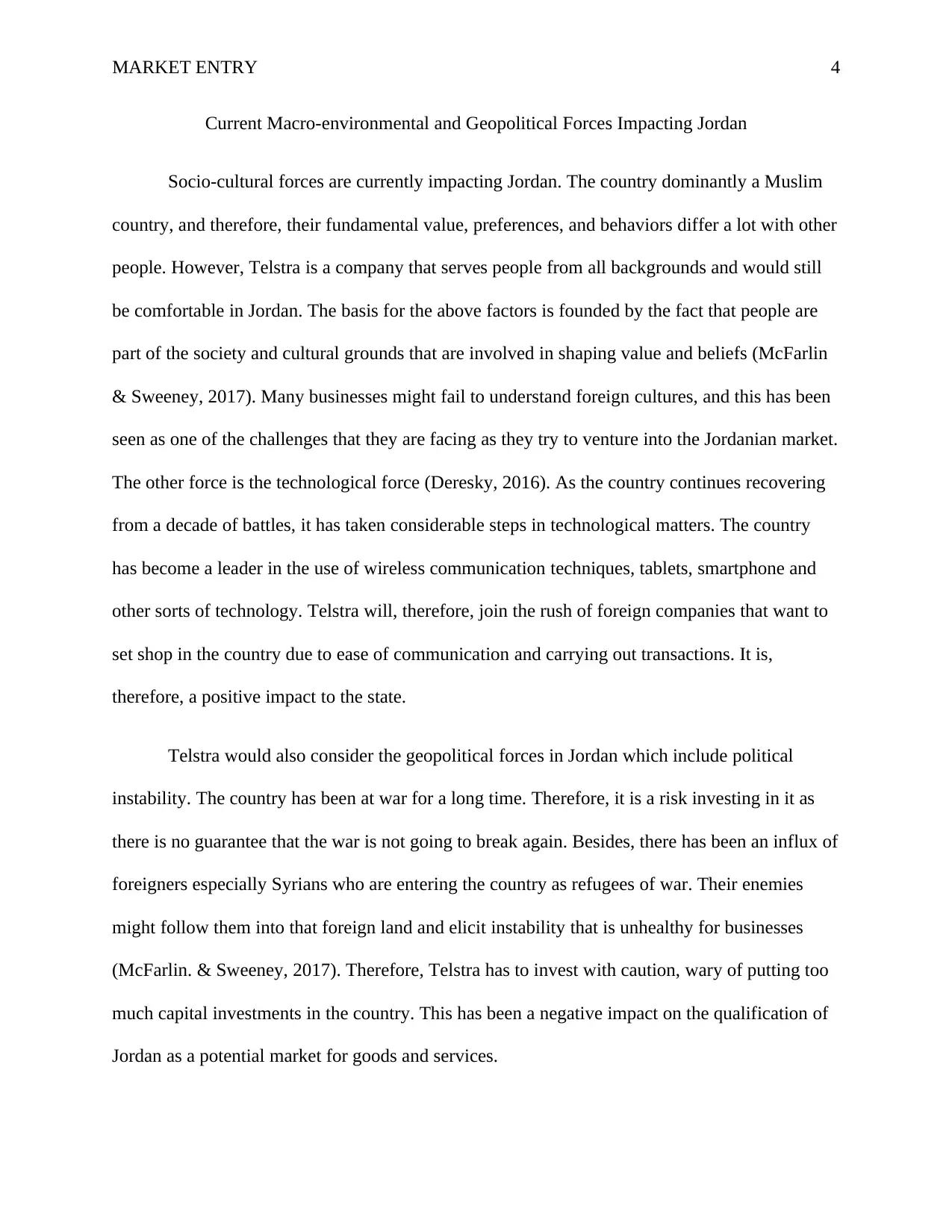
MARKET ENTRY 4
Current Macro-environmental and Geopolitical Forces Impacting Jordan
Socio-cultural forces are currently impacting Jordan. The country dominantly a Muslim
country, and therefore, their fundamental value, preferences, and behaviors differ a lot with other
people. However, Telstra is a company that serves people from all backgrounds and would still
be comfortable in Jordan. The basis for the above factors is founded by the fact that people are
part of the society and cultural grounds that are involved in shaping value and beliefs (McFarlin
& Sweeney, 2017). Many businesses might fail to understand foreign cultures, and this has been
seen as one of the challenges that they are facing as they try to venture into the Jordanian market.
The other force is the technological force (Deresky, 2016). As the country continues recovering
from a decade of battles, it has taken considerable steps in technological matters. The country
has become a leader in the use of wireless communication techniques, tablets, smartphone and
other sorts of technology. Telstra will, therefore, join the rush of foreign companies that want to
set shop in the country due to ease of communication and carrying out transactions. It is,
therefore, a positive impact to the state.
Telstra would also consider the geopolitical forces in Jordan which include political
instability. The country has been at war for a long time. Therefore, it is a risk investing in it as
there is no guarantee that the war is not going to break again. Besides, there has been an influx of
foreigners especially Syrians who are entering the country as refugees of war. Their enemies
might follow them into that foreign land and elicit instability that is unhealthy for businesses
(McFarlin. & Sweeney, 2017). Therefore, Telstra has to invest with caution, wary of putting too
much capital investments in the country. This has been a negative impact on the qualification of
Jordan as a potential market for goods and services.
Current Macro-environmental and Geopolitical Forces Impacting Jordan
Socio-cultural forces are currently impacting Jordan. The country dominantly a Muslim
country, and therefore, their fundamental value, preferences, and behaviors differ a lot with other
people. However, Telstra is a company that serves people from all backgrounds and would still
be comfortable in Jordan. The basis for the above factors is founded by the fact that people are
part of the society and cultural grounds that are involved in shaping value and beliefs (McFarlin
& Sweeney, 2017). Many businesses might fail to understand foreign cultures, and this has been
seen as one of the challenges that they are facing as they try to venture into the Jordanian market.
The other force is the technological force (Deresky, 2016). As the country continues recovering
from a decade of battles, it has taken considerable steps in technological matters. The country
has become a leader in the use of wireless communication techniques, tablets, smartphone and
other sorts of technology. Telstra will, therefore, join the rush of foreign companies that want to
set shop in the country due to ease of communication and carrying out transactions. It is,
therefore, a positive impact to the state.
Telstra would also consider the geopolitical forces in Jordan which include political
instability. The country has been at war for a long time. Therefore, it is a risk investing in it as
there is no guarantee that the war is not going to break again. Besides, there has been an influx of
foreigners especially Syrians who are entering the country as refugees of war. Their enemies
might follow them into that foreign land and elicit instability that is unhealthy for businesses
(McFarlin. & Sweeney, 2017). Therefore, Telstra has to invest with caution, wary of putting too
much capital investments in the country. This has been a negative impact on the qualification of
Jordan as a potential market for goods and services.
Paraphrase This Document
Need a fresh take? Get an instant paraphrase of this document with our AI Paraphraser
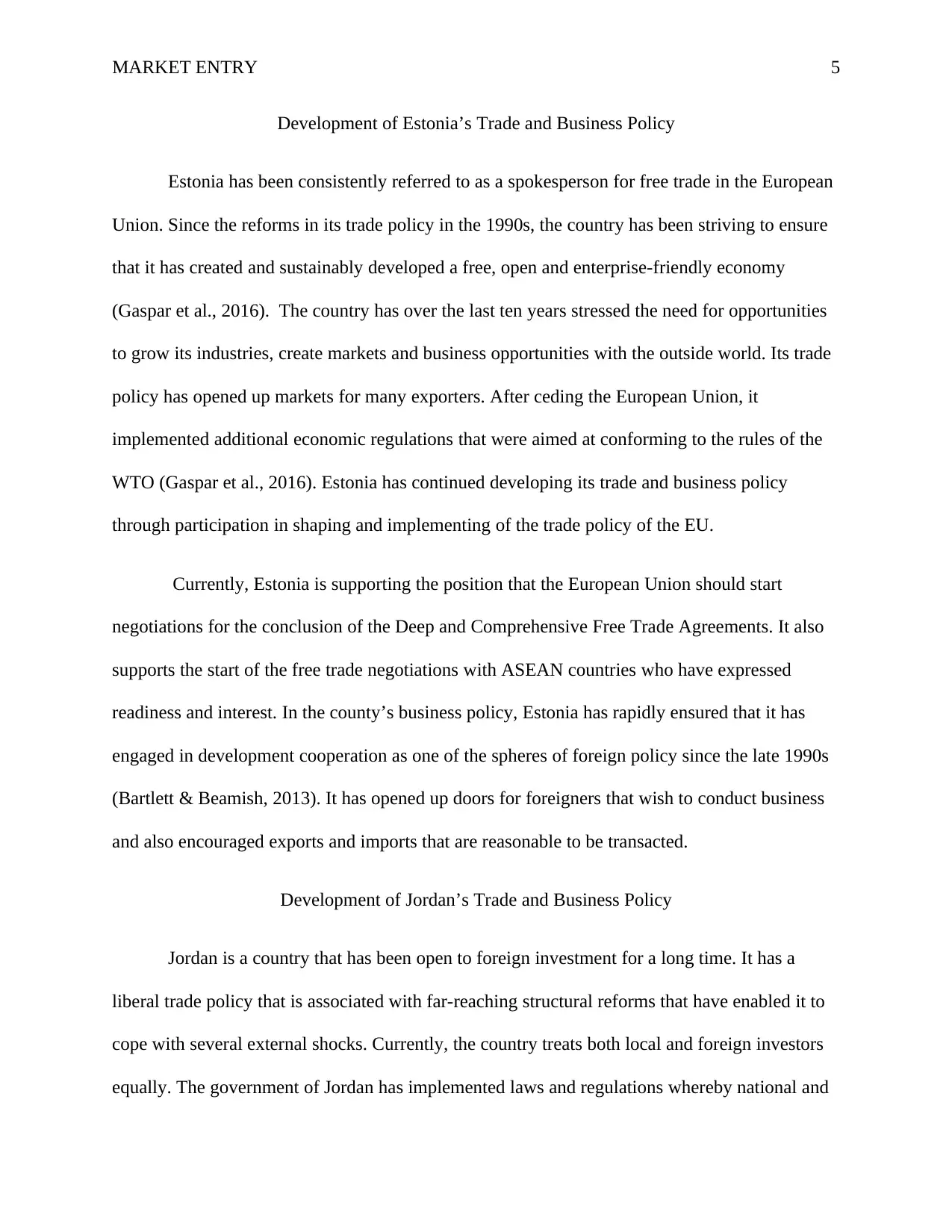
MARKET ENTRY 5
Development of Estonia’s Trade and Business Policy
Estonia has been consistently referred to as a spokesperson for free trade in the European
Union. Since the reforms in its trade policy in the 1990s, the country has been striving to ensure
that it has created and sustainably developed a free, open and enterprise-friendly economy
(Gaspar et al., 2016). The country has over the last ten years stressed the need for opportunities
to grow its industries, create markets and business opportunities with the outside world. Its trade
policy has opened up markets for many exporters. After ceding the European Union, it
implemented additional economic regulations that were aimed at conforming to the rules of the
WTO (Gaspar et al., 2016). Estonia has continued developing its trade and business policy
through participation in shaping and implementing of the trade policy of the EU.
Currently, Estonia is supporting the position that the European Union should start
negotiations for the conclusion of the Deep and Comprehensive Free Trade Agreements. It also
supports the start of the free trade negotiations with ASEAN countries who have expressed
readiness and interest. In the county’s business policy, Estonia has rapidly ensured that it has
engaged in development cooperation as one of the spheres of foreign policy since the late 1990s
(Bartlett & Beamish, 2013). It has opened up doors for foreigners that wish to conduct business
and also encouraged exports and imports that are reasonable to be transacted.
Development of Jordan’s Trade and Business Policy
Jordan is a country that has been open to foreign investment for a long time. It has a
liberal trade policy that is associated with far-reaching structural reforms that have enabled it to
cope with several external shocks. Currently, the country treats both local and foreign investors
equally. The government of Jordan has implemented laws and regulations whereby national and
Development of Estonia’s Trade and Business Policy
Estonia has been consistently referred to as a spokesperson for free trade in the European
Union. Since the reforms in its trade policy in the 1990s, the country has been striving to ensure
that it has created and sustainably developed a free, open and enterprise-friendly economy
(Gaspar et al., 2016). The country has over the last ten years stressed the need for opportunities
to grow its industries, create markets and business opportunities with the outside world. Its trade
policy has opened up markets for many exporters. After ceding the European Union, it
implemented additional economic regulations that were aimed at conforming to the rules of the
WTO (Gaspar et al., 2016). Estonia has continued developing its trade and business policy
through participation in shaping and implementing of the trade policy of the EU.
Currently, Estonia is supporting the position that the European Union should start
negotiations for the conclusion of the Deep and Comprehensive Free Trade Agreements. It also
supports the start of the free trade negotiations with ASEAN countries who have expressed
readiness and interest. In the county’s business policy, Estonia has rapidly ensured that it has
engaged in development cooperation as one of the spheres of foreign policy since the late 1990s
(Bartlett & Beamish, 2013). It has opened up doors for foreigners that wish to conduct business
and also encouraged exports and imports that are reasonable to be transacted.
Development of Jordan’s Trade and Business Policy
Jordan is a country that has been open to foreign investment for a long time. It has a
liberal trade policy that is associated with far-reaching structural reforms that have enabled it to
cope with several external shocks. Currently, the country treats both local and foreign investors
equally. The government of Jordan has implemented laws and regulations whereby national and
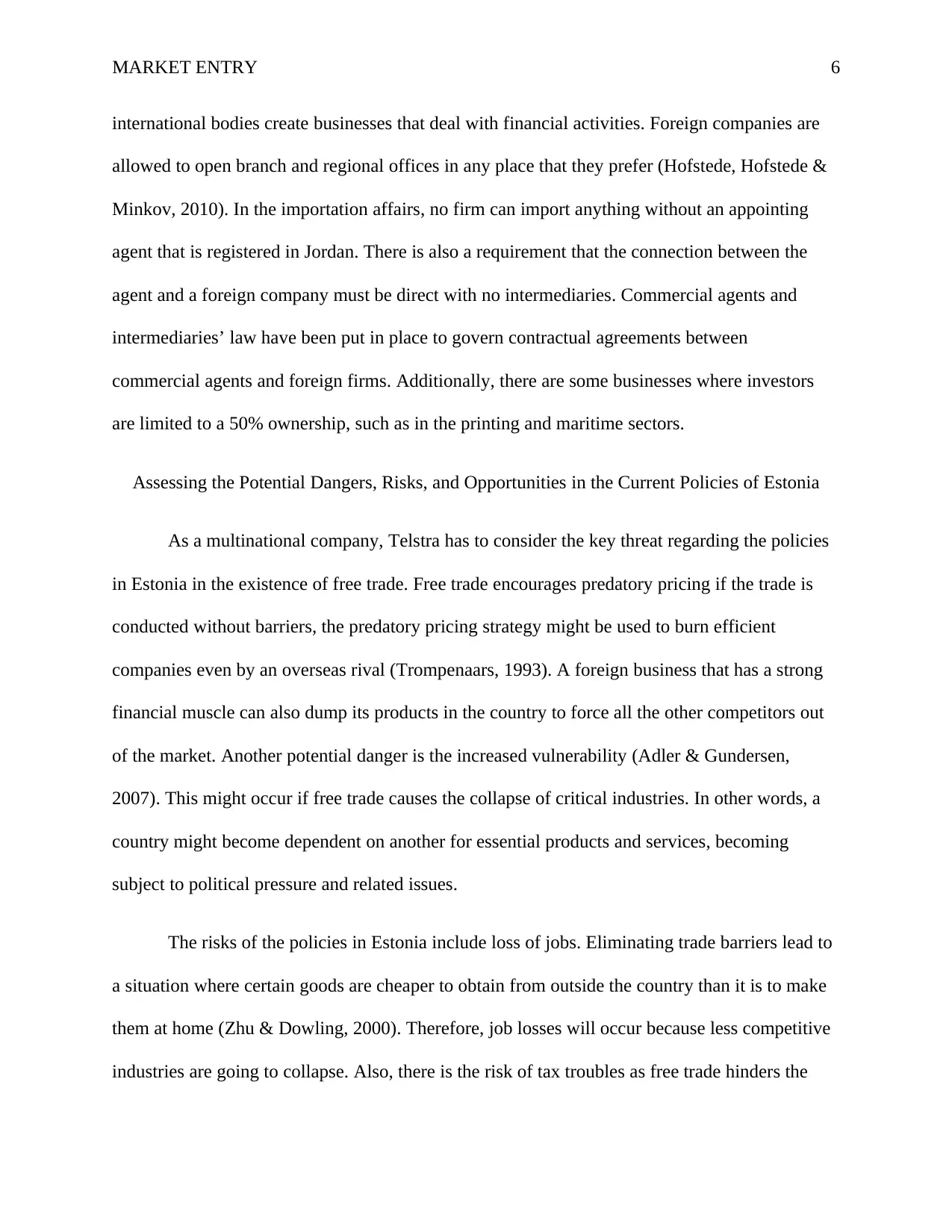
MARKET ENTRY 6
international bodies create businesses that deal with financial activities. Foreign companies are
allowed to open branch and regional offices in any place that they prefer (Hofstede, Hofstede &
Minkov, 2010). In the importation affairs, no firm can import anything without an appointing
agent that is registered in Jordan. There is also a requirement that the connection between the
agent and a foreign company must be direct with no intermediaries. Commercial agents and
intermediaries’ law have been put in place to govern contractual agreements between
commercial agents and foreign firms. Additionally, there are some businesses where investors
are limited to a 50% ownership, such as in the printing and maritime sectors.
Assessing the Potential Dangers, Risks, and Opportunities in the Current Policies of Estonia
As a multinational company, Telstra has to consider the key threat regarding the policies
in Estonia in the existence of free trade. Free trade encourages predatory pricing if the trade is
conducted without barriers, the predatory pricing strategy might be used to burn efficient
companies even by an overseas rival (Trompenaars, 1993). A foreign business that has a strong
financial muscle can also dump its products in the country to force all the other competitors out
of the market. Another potential danger is the increased vulnerability (Adler & Gundersen,
2007). This might occur if free trade causes the collapse of critical industries. In other words, a
country might become dependent on another for essential products and services, becoming
subject to political pressure and related issues.
The risks of the policies in Estonia include loss of jobs. Eliminating trade barriers lead to
a situation where certain goods are cheaper to obtain from outside the country than it is to make
them at home (Zhu & Dowling, 2000). Therefore, job losses will occur because less competitive
industries are going to collapse. Also, there is the risk of tax troubles as free trade hinders the
international bodies create businesses that deal with financial activities. Foreign companies are
allowed to open branch and regional offices in any place that they prefer (Hofstede, Hofstede &
Minkov, 2010). In the importation affairs, no firm can import anything without an appointing
agent that is registered in Jordan. There is also a requirement that the connection between the
agent and a foreign company must be direct with no intermediaries. Commercial agents and
intermediaries’ law have been put in place to govern contractual agreements between
commercial agents and foreign firms. Additionally, there are some businesses where investors
are limited to a 50% ownership, such as in the printing and maritime sectors.
Assessing the Potential Dangers, Risks, and Opportunities in the Current Policies of Estonia
As a multinational company, Telstra has to consider the key threat regarding the policies
in Estonia in the existence of free trade. Free trade encourages predatory pricing if the trade is
conducted without barriers, the predatory pricing strategy might be used to burn efficient
companies even by an overseas rival (Trompenaars, 1993). A foreign business that has a strong
financial muscle can also dump its products in the country to force all the other competitors out
of the market. Another potential danger is the increased vulnerability (Adler & Gundersen,
2007). This might occur if free trade causes the collapse of critical industries. In other words, a
country might become dependent on another for essential products and services, becoming
subject to political pressure and related issues.
The risks of the policies in Estonia include loss of jobs. Eliminating trade barriers lead to
a situation where certain goods are cheaper to obtain from outside the country than it is to make
them at home (Zhu & Dowling, 2000). Therefore, job losses will occur because less competitive
industries are going to collapse. Also, there is the risk of tax troubles as free trade hinders the
⊘ This is a preview!⊘
Do you want full access?
Subscribe today to unlock all pages.

Trusted by 1+ million students worldwide
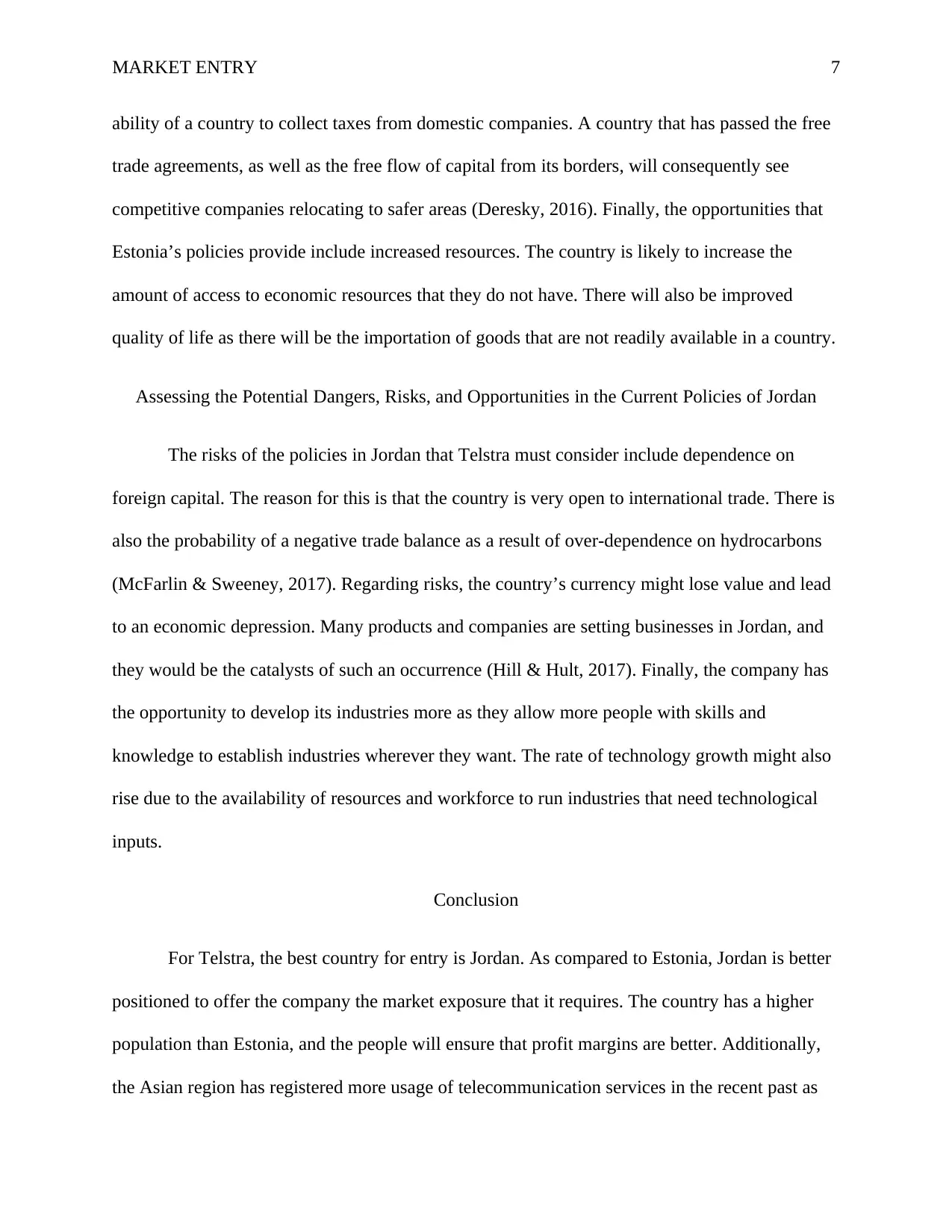
MARKET ENTRY 7
ability of a country to collect taxes from domestic companies. A country that has passed the free
trade agreements, as well as the free flow of capital from its borders, will consequently see
competitive companies relocating to safer areas (Deresky, 2016). Finally, the opportunities that
Estonia’s policies provide include increased resources. The country is likely to increase the
amount of access to economic resources that they do not have. There will also be improved
quality of life as there will be the importation of goods that are not readily available in a country.
Assessing the Potential Dangers, Risks, and Opportunities in the Current Policies of Jordan
The risks of the policies in Jordan that Telstra must consider include dependence on
foreign capital. The reason for this is that the country is very open to international trade. There is
also the probability of a negative trade balance as a result of over-dependence on hydrocarbons
(McFarlin & Sweeney, 2017). Regarding risks, the country’s currency might lose value and lead
to an economic depression. Many products and companies are setting businesses in Jordan, and
they would be the catalysts of such an occurrence (Hill & Hult, 2017). Finally, the company has
the opportunity to develop its industries more as they allow more people with skills and
knowledge to establish industries wherever they want. The rate of technology growth might also
rise due to the availability of resources and workforce to run industries that need technological
inputs.
Conclusion
For Telstra, the best country for entry is Jordan. As compared to Estonia, Jordan is better
positioned to offer the company the market exposure that it requires. The country has a higher
population than Estonia, and the people will ensure that profit margins are better. Additionally,
the Asian region has registered more usage of telecommunication services in the recent past as
ability of a country to collect taxes from domestic companies. A country that has passed the free
trade agreements, as well as the free flow of capital from its borders, will consequently see
competitive companies relocating to safer areas (Deresky, 2016). Finally, the opportunities that
Estonia’s policies provide include increased resources. The country is likely to increase the
amount of access to economic resources that they do not have. There will also be improved
quality of life as there will be the importation of goods that are not readily available in a country.
Assessing the Potential Dangers, Risks, and Opportunities in the Current Policies of Jordan
The risks of the policies in Jordan that Telstra must consider include dependence on
foreign capital. The reason for this is that the country is very open to international trade. There is
also the probability of a negative trade balance as a result of over-dependence on hydrocarbons
(McFarlin & Sweeney, 2017). Regarding risks, the country’s currency might lose value and lead
to an economic depression. Many products and companies are setting businesses in Jordan, and
they would be the catalysts of such an occurrence (Hill & Hult, 2017). Finally, the company has
the opportunity to develop its industries more as they allow more people with skills and
knowledge to establish industries wherever they want. The rate of technology growth might also
rise due to the availability of resources and workforce to run industries that need technological
inputs.
Conclusion
For Telstra, the best country for entry is Jordan. As compared to Estonia, Jordan is better
positioned to offer the company the market exposure that it requires. The country has a higher
population than Estonia, and the people will ensure that profit margins are better. Additionally,
the Asian region has registered more usage of telecommunication services in the recent past as
Paraphrase This Document
Need a fresh take? Get an instant paraphrase of this document with our AI Paraphraser
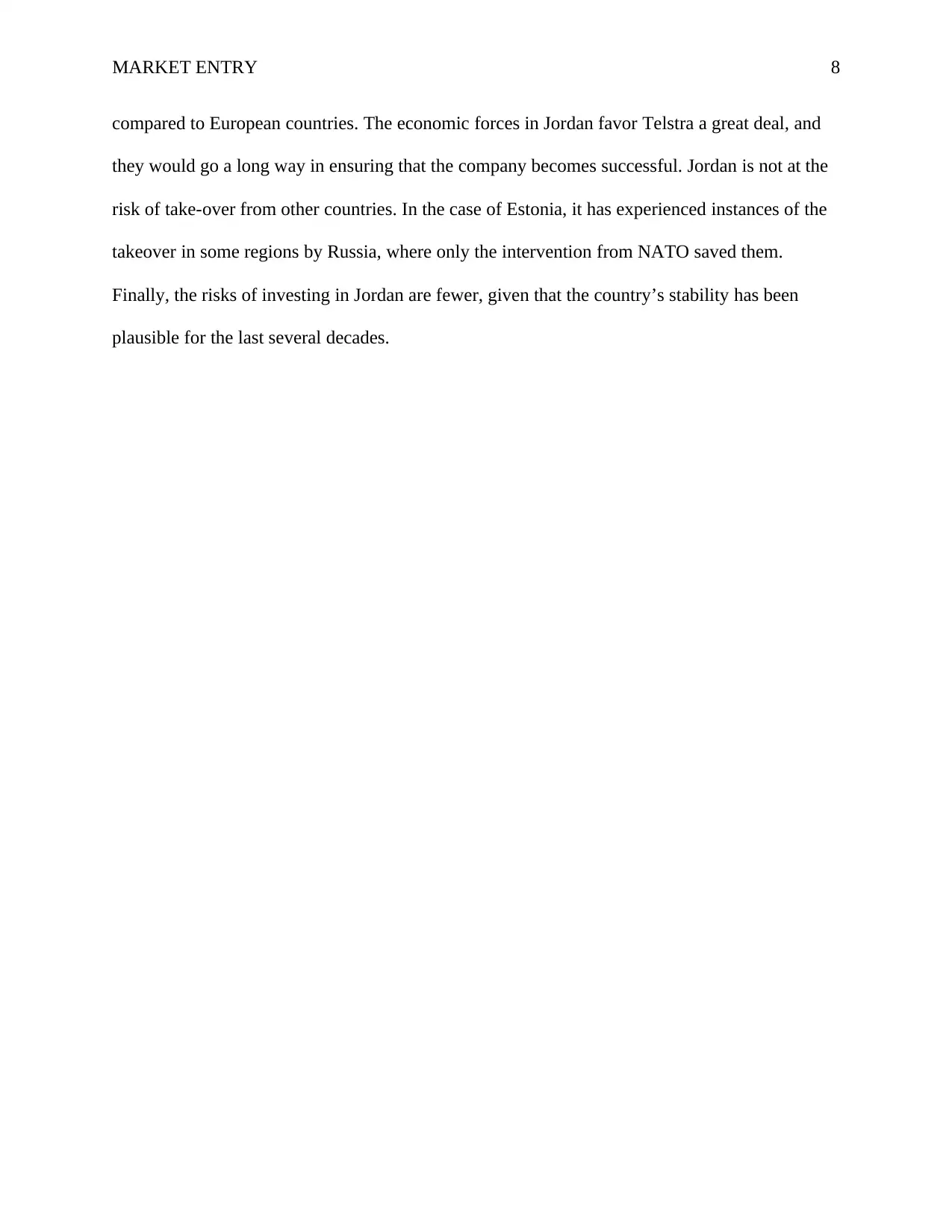
MARKET ENTRY 8
compared to European countries. The economic forces in Jordan favor Telstra a great deal, and
they would go a long way in ensuring that the company becomes successful. Jordan is not at the
risk of take-over from other countries. In the case of Estonia, it has experienced instances of the
takeover in some regions by Russia, where only the intervention from NATO saved them.
Finally, the risks of investing in Jordan are fewer, given that the country’s stability has been
plausible for the last several decades.
compared to European countries. The economic forces in Jordan favor Telstra a great deal, and
they would go a long way in ensuring that the company becomes successful. Jordan is not at the
risk of take-over from other countries. In the case of Estonia, it has experienced instances of the
takeover in some regions by Russia, where only the intervention from NATO saved them.
Finally, the risks of investing in Jordan are fewer, given that the country’s stability has been
plausible for the last several decades.
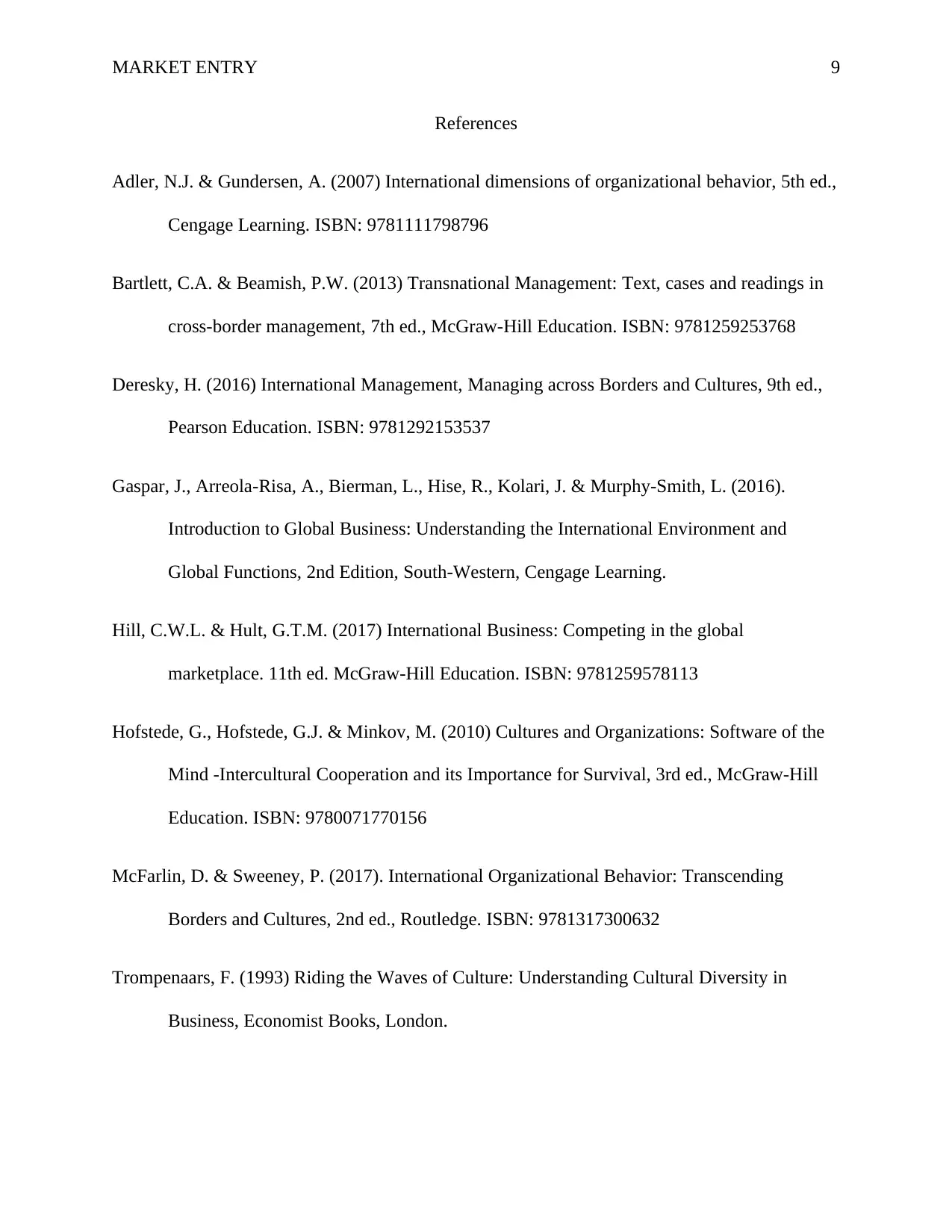
MARKET ENTRY 9
References
Adler, N.J. & Gundersen, A. (2007) International dimensions of organizational behavior, 5th ed.,
Cengage Learning. ISBN: 9781111798796
Bartlett, C.A. & Beamish, P.W. (2013) Transnational Management: Text, cases and readings in
cross-border management, 7th ed., McGraw-Hill Education. ISBN: 9781259253768
Deresky, H. (2016) International Management, Managing across Borders and Cultures, 9th ed.,
Pearson Education. ISBN: 9781292153537
Gaspar, J., Arreola-Risa, A., Bierman, L., Hise, R., Kolari, J. & Murphy-Smith, L. (2016).
Introduction to Global Business: Understanding the International Environment and
Global Functions, 2nd Edition, South-Western, Cengage Learning.
Hill, C.W.L. & Hult, G.T.M. (2017) International Business: Competing in the global
marketplace. 11th ed. McGraw-Hill Education. ISBN: 9781259578113
Hofstede, G., Hofstede, G.J. & Minkov, M. (2010) Cultures and Organizations: Software of the
Mind -Intercultural Cooperation and its Importance for Survival, 3rd ed., McGraw-Hill
Education. ISBN: 9780071770156
McFarlin, D. & Sweeney, P. (2017). International Organizational Behavior: Transcending
Borders and Cultures, 2nd ed., Routledge. ISBN: 9781317300632
Trompenaars, F. (1993) Riding the Waves of Culture: Understanding Cultural Diversity in
Business, Economist Books, London.
References
Adler, N.J. & Gundersen, A. (2007) International dimensions of organizational behavior, 5th ed.,
Cengage Learning. ISBN: 9781111798796
Bartlett, C.A. & Beamish, P.W. (2013) Transnational Management: Text, cases and readings in
cross-border management, 7th ed., McGraw-Hill Education. ISBN: 9781259253768
Deresky, H. (2016) International Management, Managing across Borders and Cultures, 9th ed.,
Pearson Education. ISBN: 9781292153537
Gaspar, J., Arreola-Risa, A., Bierman, L., Hise, R., Kolari, J. & Murphy-Smith, L. (2016).
Introduction to Global Business: Understanding the International Environment and
Global Functions, 2nd Edition, South-Western, Cengage Learning.
Hill, C.W.L. & Hult, G.T.M. (2017) International Business: Competing in the global
marketplace. 11th ed. McGraw-Hill Education. ISBN: 9781259578113
Hofstede, G., Hofstede, G.J. & Minkov, M. (2010) Cultures and Organizations: Software of the
Mind -Intercultural Cooperation and its Importance for Survival, 3rd ed., McGraw-Hill
Education. ISBN: 9780071770156
McFarlin, D. & Sweeney, P. (2017). International Organizational Behavior: Transcending
Borders and Cultures, 2nd ed., Routledge. ISBN: 9781317300632
Trompenaars, F. (1993) Riding the Waves of Culture: Understanding Cultural Diversity in
Business, Economist Books, London.
⊘ This is a preview!⊘
Do you want full access?
Subscribe today to unlock all pages.

Trusted by 1+ million students worldwide
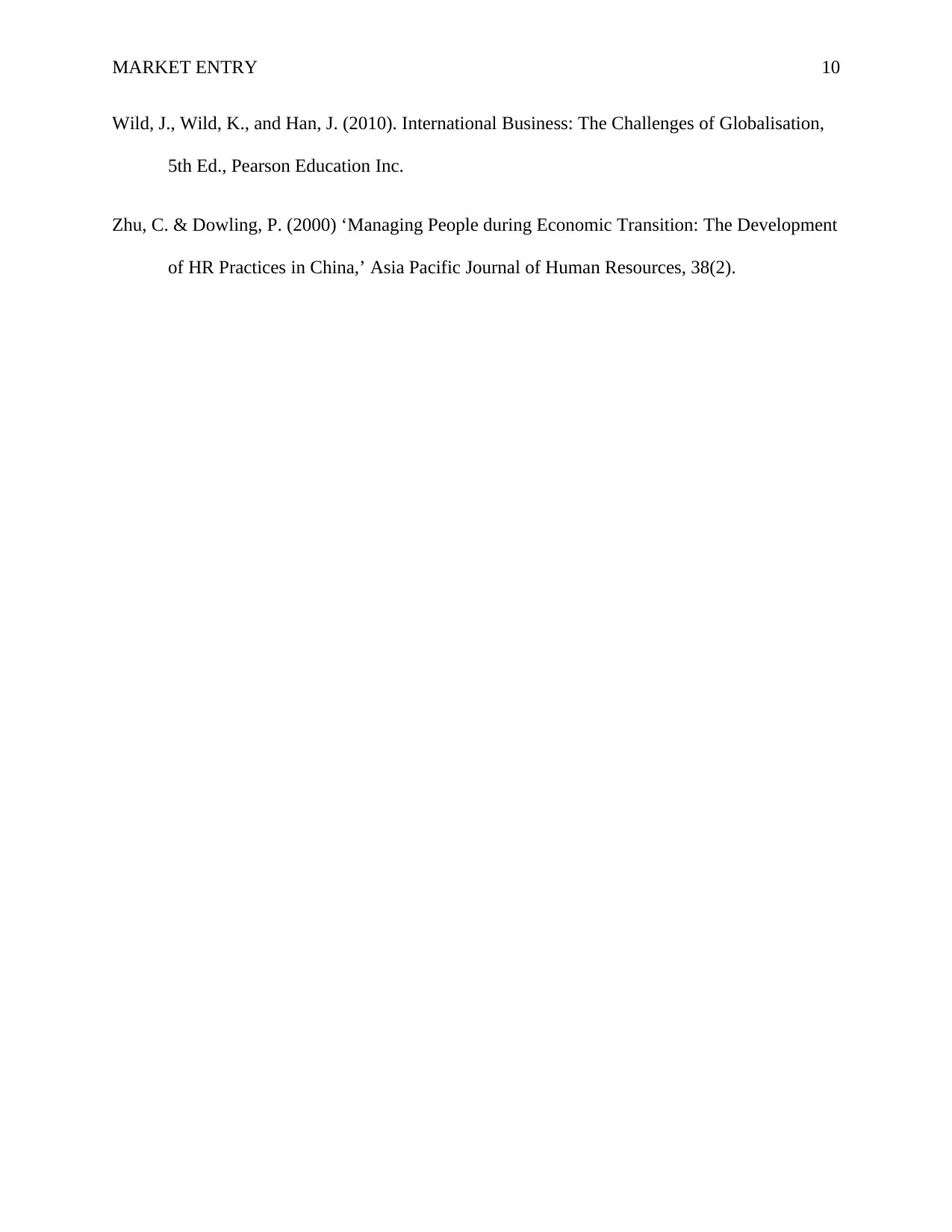
MARKET ENTRY 10
Wild, J., Wild, K., and Han, J. (2010). International Business: The Challenges of Globalisation,
5th Ed., Pearson Education Inc.
Zhu, C. & Dowling, P. (2000) ‘Managing People during Economic Transition: The Development
of HR Practices in China,’ Asia Pacific Journal of Human Resources, 38(2).
Wild, J., Wild, K., and Han, J. (2010). International Business: The Challenges of Globalisation,
5th Ed., Pearson Education Inc.
Zhu, C. & Dowling, P. (2000) ‘Managing People during Economic Transition: The Development
of HR Practices in China,’ Asia Pacific Journal of Human Resources, 38(2).
1 out of 10
Related Documents
Your All-in-One AI-Powered Toolkit for Academic Success.
+13062052269
info@desklib.com
Available 24*7 on WhatsApp / Email
![[object Object]](/_next/static/media/star-bottom.7253800d.svg)
Unlock your academic potential
Copyright © 2020–2025 A2Z Services. All Rights Reserved. Developed and managed by ZUCOL.





